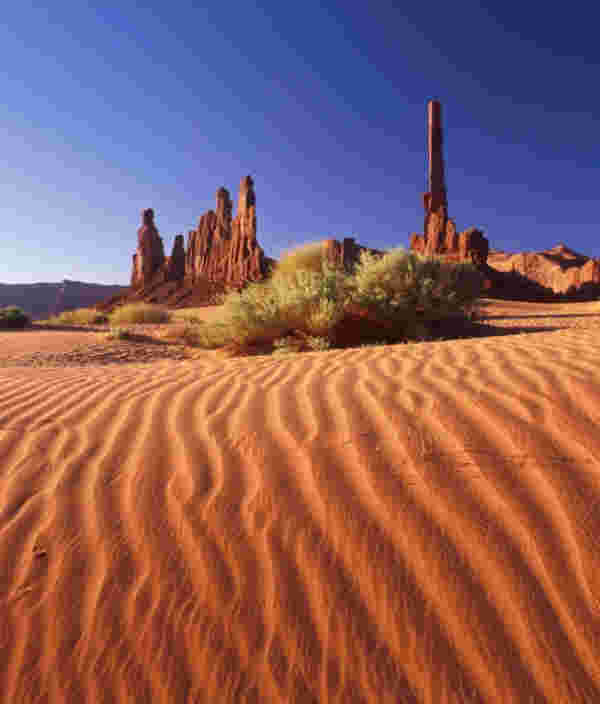BACKGROUND:
Sand has been used to describe many human attributes. A vagabond has been
referred to as "driftless like ...sand"; endless time is called
"sand that drifts forever"; we are all but a "grain of sand
on the beach." Children can spend endless hours on the beach, creating
sand castles, or digging to reach the other side of the world. Sand is clean
to play with; it can cover you up, but not make you dirty. Sand is loved so
much by children that adults have created sand boxes, so their children can
play with it.
Sand is very important in manufacturing industries. Pure quartz sand is
the raw material for making glass. Other sands are also used to make
pottery, to line the hearth of acid steel furnaces, for molding metal casts,
and as abrasives (garnet-rich sands). Sand is also important in the cement
business; it is an important component of concrete. Imagine an
industrialized country without concrete: no large buildings, no highways, no
slab housing, no large pipelines (especially sewage), and so on.
Sandstone layers within the earth are important to the petroleum
industries. The spaces between the sand grains in these layers may be filled
with oil and gas. Sandstone thus acts like a holding tank for petroleum,
just waiting for humans to tap them.
Sand, is defined as any loose, granular material between upper and lower
size ranges (in the United States - 1/16mm - 2mm). Sand is created in a
number of ways:
 WEATHERING
is the mechanical breakdown and chemical decay of rocks. An example of the
former is frost wedging. In wet areas, water fills the cracks in rocks. When
the temperature drops below freezing, the water in the cracks turns into
ice. The ice expands, and forces the cracks apart. The ice then melts as the
weather warms up. The rock thus becomes weaker and the crack become
wider with each successive freeze-thaw cycle. The rock eventually breaks
apart into many pieces. Decomposition of a rock converts less resistant,
chemically unstable minerals stable forms. For example, at the earth’s
surface, feldspar decomposes into clay. These two types of weathering work
together to break down rocks. For example, the decomposition of the unstable
minerals in a rock allows the remaining resistant minerals to fall out.
WEATHERING
is the mechanical breakdown and chemical decay of rocks. An example of the
former is frost wedging. In wet areas, water fills the cracks in rocks. When
the temperature drops below freezing, the water in the cracks turns into
ice. The ice expands, and forces the cracks apart. The ice then melts as the
weather warms up. The rock thus becomes weaker and the crack become
wider with each successive freeze-thaw cycle. The rock eventually breaks
apart into many pieces. Decomposition of a rock converts less resistant,
chemically unstable minerals stable forms. For example, at the earth’s
surface, feldspar decomposes into clay. These two types of weathering work
together to break down rocks. For example, the decomposition of the unstable
minerals in a rock allows the remaining resistant minerals to fall out.
VOLCANIC EXPLOSIONS can create sand size particles of glass,
crystal fragments, and lava particles. The particles will settle out onto
land, or when an underwater volcanic eruption takes place, into the sea.
CRUSHING and ABRASION take place when rocks are physically
broken up during transport. For example, as they move, glaciers often break
larger rocks into sand size particles. Further abrasive action results in
clay size particles. Small particles loosened and carried by wind can abrade
or "sandblast" other rocks.
PELLETS created in the guts of little organisms also can form
sand-sized particles. Many organisms on the bottom of the ocean are debris
feeders, scooping up mud, digesting it for food and then excreting the
remaining material in pellet form. Large portions of the ocean floor are
covered with such pellets.
PRECIPITATION of minerals from water
supersaturated with calcium carbonate can produce sand-sized grains called
oolites. Oolites (which means egg shaped) form in warm shallow ocean water,
along beaches in places like Florida and Australia. In addition, the
skeletons of marine organisms, which are biologically precipitated, can
break up after the organism’s death to form sand-sized fragments.
PROCEDURE:
- Discuss the rock cycle. Introduce sand as "miniature rocks"
reflecting the parent rock that it eroded from. Use the sand kit to show
students different types of sand that can be found at beaches. Different
processes create different types of sand. Sand can be formed in deserts
as well as rivers.
- Use the diagram to show students where weathering, erosion, and
deposition take place. Explain how this is a part of the Rock Cycle.
Sediments travel from the land to the ocean by rivers, streams, and
creeks. These sediments will settle out in the ocean or lake from
heaviest to lightest.